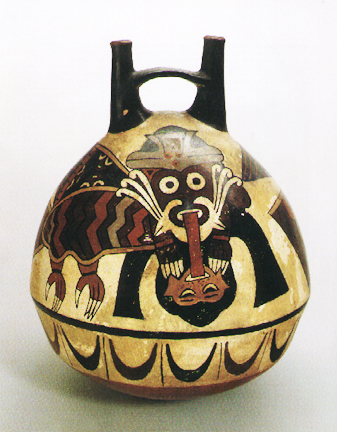
Nazca double-spouted vase,
Earthenware with polychrome slips , South Coastal Peru
Classic Period, 100-700 CE
ART 198 - HISTORY OF WORLD CERAMICS
| Another important culture of Precolumbian South America is the Nazca, located in the southern coastal areas of what is now Peru. Nazca settlements were in the valleys in the region of the Nazca River, near the Pacific. They made finely coiled pottery that was burnished and painted in as many as eight slip colors: yellow, green, black, violet, red, white, and an off-white, cream color. Rarely were all eight colors used on the same vessel, but five of those colors can be seen on this example. No written language existed to record the meanings of these images, but the image is assumed to represent a cat-like deity. They were influenced by the preceding Paracas culture, and usually painted their images in solid colors, with black outlines. This Nazca vessel features the typical double spout with a bridge which makes an effective carrying handle. This particular image is painted on numerous pots, and its precise identification is unknown, but it is usually referred to as a 'supernatural being.' It does have zoomorphic attributes, seeming to combine a cat's mouth and head with a centipede-like body, here with hands. | Nazca double-spouted vase, Earthenware with polychrome slips , South Coastal Peru Classic Period, 100-700 CE |
|
|